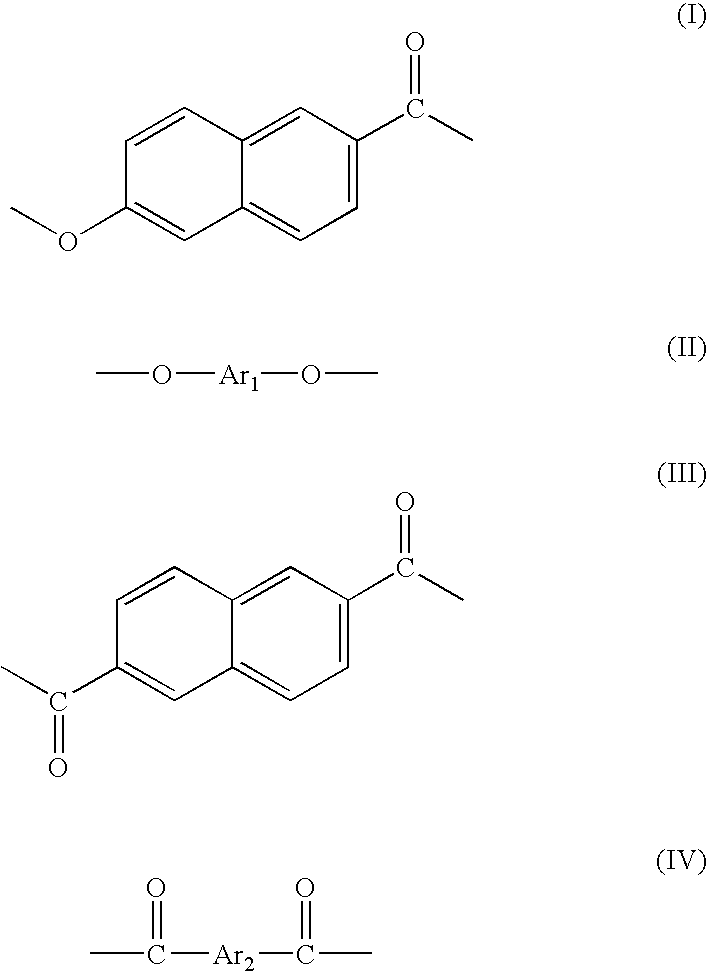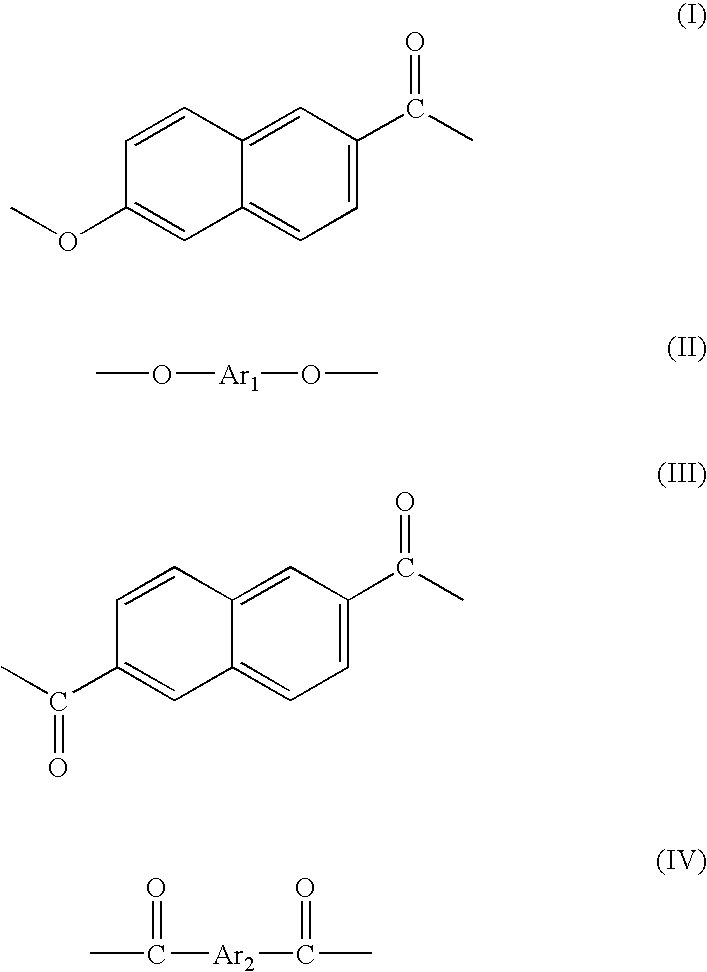Aromatic liquid-crystalline polyester
a liquid crystal polyester and polyester technology, applied in the direction of synthetic resin layered products, non-metal conductors, conductors, etc., can solve the problems of difficult moldability of polyester into a film by injection method or tubular method, and achieve excellent moldability and small dielectric loss.
- Summary
- Abstract
- Description
- Claims
- Application Information
AI Technical Summary
Benefits of technology
Problems solved by technology
Method used
Image
Examples
example 1
[0114]2-hydroxy-6-naphthoic acid (940.9 g, 5.0 mol), 4,4′-dihydroxybiphenyl (512.08 g, 2.75 mol, in which excess amount of 0.25 mole was included), 2,6-naphthalene dicarboxylic acid (497.24 g, 2.3 mol), terephthalic acid (33.23 g, 0.2 mol), acetic anhydride (1179.14 g, 11.5 mol) and 1-methyl imidazole (0.198 g) as a catalyst were added into a reactor equipped with a stirrer, torque meter, nitrogen gas introduction tube, thermometer and reflux condenser. After stirring at room temperature for 15 minutes, the reactor was heated with stirring. When the inner temperature of the reactor reached 145° C., 1-methyl imidazole (5.94 g) was further added while the temperature is kept at the same temperature with stirring for additional 1 hour.
[0115]Then, the temperature was increased from 145° C. to 310° C. in 3 hours and 30 minutes while acetic acid as a by-product and unreacted acetic anhydride were removed by distillation. An aromatic polyester prepolymer was obtained by keeping the tempera...
example 2
[0118]2-hydroxy-6-naphthoic acid (940.9 g, 5.0 mol), hydroquinone (302.80 g, 2.75 mol, in which excess amount of 0.25 mole was included), 2,6-naphthalene dicarboxylic acid (497.24 g, 2.3 mol), terephthalic acid (33.23 g, 0.2 mol), acetic anhydride (1232.74 g, 12.08 mol) and 1-methyl imidazole (0.17 g) as a catalyst were added into a reactor as used in Example 1. After stirring at room temperature for 15 minutes, the reactor was heated with stirring. After the inner temperature of the reactor reached 145° C., the temperature is kept at the same temperature with stirring for additional 1 hour.
[0119]Then, the temperature was increased from 145° C. to 310° C. in 3 hours and 30 minutes while acetic acid as a by-product and unreacted acetic anhydride were removed by distillation. An aromatic polyester prepolymer was obtained by keeping the temperature for 2 hours. The aromatic polyester prepolymer was cooled to room temperature, and was pulverized with a pulverizer to obtain a powder of t...
example 3
[0122]2-hydroxy-6-naphthoic acid (940.9 g, 5.0 mol), hydroquinone (302.80 g, 2.75 mol, in which excess amount of 0.25 mole was included) 2,6-naphthalene dicarboxylic acid (432.38 g, 2.0 mol), terephthalic acid (83.07 g, 0.5 mol), acetic anhydride (1232.74 g, 12.08 mol) and 1-methyl imidazole (0.17 g) as a catalyst were added into a reactor as used in Example 1. After stirring at room temperature for 15 minutes, the reactor was heated with stirring. After the inner temperature of the reactor reached 145° C., the temperature is kept at the same temperature with stirring for additional 1 hour.
[0123]Then, the temperature was increased from 145° C. to 310° C. in 3 hours and 30 minutes while acetic acid as a by-product and unreacted acetic anhydride were removed by distillation. An aromatic polyester prepolymer was obtained by keeping the temperature for 2 hours and 15 minutes. The aromatic polyester prepolymer was cooled to room temperature, and was pulverized with a pulverizer to obtain...
PUM
| Property | Measurement | Unit |
|---|---|---|
| flow-initiating temperature | aaaaa | aaaaa |
| temperature | aaaaa | aaaaa |
| temperature | aaaaa | aaaaa |
Abstract
Description
Claims
Application Information
 Login to View More
Login to View More - R&D
- Intellectual Property
- Life Sciences
- Materials
- Tech Scout
- Unparalleled Data Quality
- Higher Quality Content
- 60% Fewer Hallucinations
Browse by: Latest US Patents, China's latest patents, Technical Efficacy Thesaurus, Application Domain, Technology Topic, Popular Technical Reports.
© 2025 PatSnap. All rights reserved.Legal|Privacy policy|Modern Slavery Act Transparency Statement|Sitemap|About US| Contact US: help@patsnap.com



